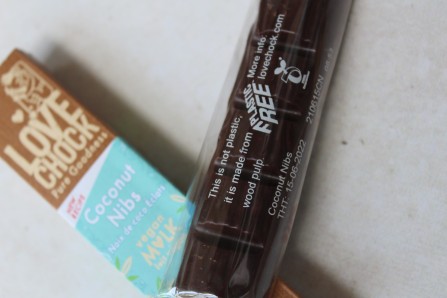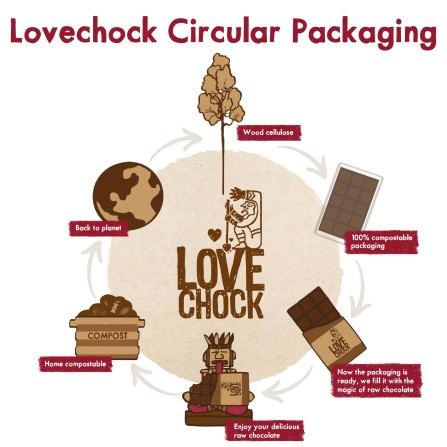10 years of plastic free packaging – wow!
That makes us pretty proud. But what is the difference between “normal”, single use plastic and a plastic free packaging foil?
Producing conventional plastic requires mineral oil as a raw material which needs to be exploited from deep under the earth and is brought to the surface at great expense. In the refining process, the crude oil is processed into gases, petrol and propylene. In order to get ethylene and propylene to make plastic, the crude oil has to be cracked. It is then refined and further processed into plastic pellets, which are then melted down and moulded into the respective plastic packaging. That's the short version but the bottom line is: plastic raw materials are not renewable and therefore unsustainable, and its production (and disposal) is very harmful to the environment. After all, around 556 billion litres of petroleum are used up every year to produce plastic packagings, and more than 400 million tonnes of carbon dioxide are emitted annually from the production process alone.
Going from bad to worse, plastic packaging is very rarely recycled because it usually consists of many different plastics that have been processed together. Most of it just goes to landfill or gets burned, causing emission of CO2 and toxic gases.
At Lovechock, we have always been keen to avoid the highly polluting production and disposal of plastic, which led us to start searching for alternative materials for our chocolate packaging back in 2010. That’s why we started using a transparent foil made from compostable wood cellulose. We have now happily been using this alternative material for 10 years and saved a whopping 23.000 kilograms of plastic in the process! While our foil might still look like plastic to you, it is actually fully home compostable because it is made from eucalyptus tree pulp - a renewable resource from sustainable forestry. Unfortunately, our compostable foil cannot yet be industrially composted in every country which means you cannot yet dispose of it in the organic waste “green bin”. It still goes to landfill in some countries or is burned in the residual waste but at least our cellulose foil does not emit any toxic gases when burned, nor is any polluting mineral oil required for its production.

Recycling, composting, residual waste, carton, plastic?
Are you utterly confused by the different waste disposal options, too? We are all happy about the increasing amount of sustainable packaging solutions - but how to dispose of them in the right way? Here is some background and tips on the best way to throw away our environmentally friendly and plastic free foil in your country.
What is the best way to dispose of our plastic free foil?
Well, the best way to dispose of our plastic free foil is if you just put it in your own home compost. A home compost provides the ideal conditions for our foil to decompose and return to the biological cycle as "biomass". After 10-12 weeks, the foil will be completely dissolved. By the way: A home compost, or worm hotel, is a great way to dispose of your organic waste such as apple leftovers. But be careful, not everything belongs in your home compost. Read here what you can best put in there.

You don't have your own compost or “worm hotel”?
Unfortunately, that’s when things are still a bit more tricky due to the different waste management systems. While it is often advertised that plastic free cellulose foils may be thrown into the organic waste bin (“Biotonne” or green bin), the German Federal Environment Agency or Dutch waste management company Attero for example explicitly recommend not to do so but to throw them in the residual waste or the yellow bag (“Gelber Sack”) instead.
In case that compostable plastics such as our cellulose foil do land in the organic waste (green bin or Biotonne), they are actually picked out at the composting facilities. The reasons lie in the current waste separation systems. In Germany, this is even regulated at communal level and differs from region to region which makes it difficult to give disposal advice that is generally applicable.
More importantly, the composting factories are not yet prepared for environmentally friendly and compostable foils. According to current requirements for industrial composting, organic waste must decompose in about four to five weeks. Cellulose foil needs about 10 weeks to decompose and there is no faster alternative on the sustainable packaging market yet.
It is a similar situation in the Netherlands where the foil should go into the normal (rest) waste bin, too. Packaging with logos such as "kiemplantlogo" or "ok compostlogo" should always be disposed of in the normal waste and never in the green waste (GFT). The green waste goes to industrial composting plants which are designed to compost very fast within 2 - 8 weeks. Products with compost logos such as kiemplant or OK compost on the other hand are certified to compost within 12 weeks.
So what happens to the foil when correctly disposing of it in the ‘rest’ bin?
The best thing for the environment would be to recycle compostable plastics to save on raw materials for the production of new compostable plastics. But since there is still so very little compostable packaging around, it is currently too expensive for the waste companies to invest in new recycling machines that can process compostable foil. Only once a sufficient level of compostable packaging is in the system will the investment become cost efficient. This means that currently, compostable plastics like our compostable foil are unfortunately still simply burnt along with the rest of the residual waste. On the plus side: contrary to normal plastics, compostable plastics don’t release toxic gases when burnt and in the Netherlands, green energy is generated from the heat of burning the rest waste.
The situation in France is very similar to the Netherlands. The only difference is that there is no green bin or industrial recycling yet. That's why it is best to have a compost bin at home and dispose of the foil there. If you don't have one, just put it in the normal residual waste. We have heard that neighbourhoods or small villages in France often share a compost and we love it! What a great and cooperative way to a more sustainable future.
Together with you and other sustainable brands, we want to raise awareness for the plastic problem on earth. We think that it is a shame that the recycling industry is not stepping up their game to promote and support alternative plastic free materials. And even though a home compost remains the best way to compost our compostable packaging for now (and we do recognise that many people don’t have one), it is important to us to show that there are really good, sustainable plastic alternatives already. We believe that this is the only way in which we can help create a future in which more waste will be separated, recycled, composted and best of all, avoided.

